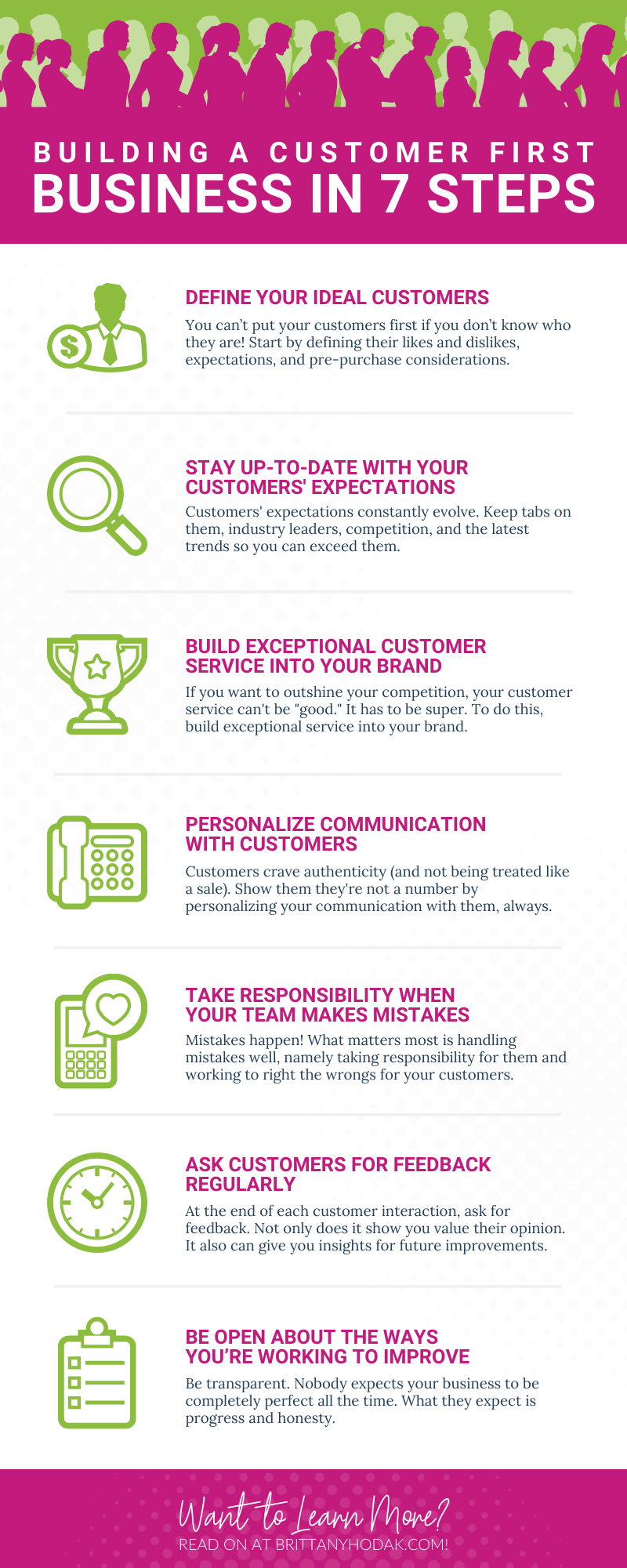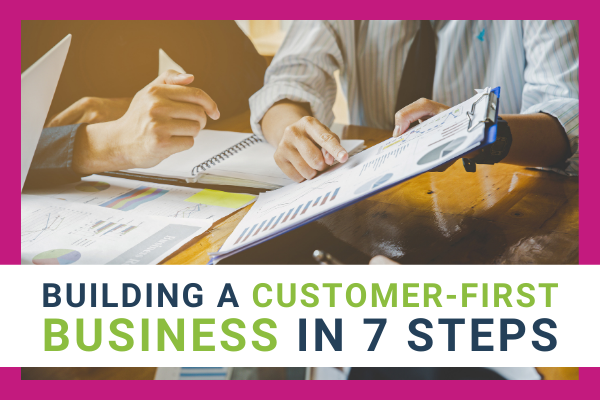Though just about every company claims to focus on customer satisfaction first and foremost, how often is that actually the case? In reality, your customers’ wants and needs are often an afterthought compared to your other strategies.
At its essence, being customer first means always putting your customers at the center of every decision. While this seems like a natural, obvious choice, too many organizations continue to fall short when it matters most.
Being customer first as a brand means always keeping your customers at the heart of every decision. How will your next step as an organization affect your customers? Will new products or offerings benefit your customer experience and in what ways? These are the key questions to ask every time if you want to create more superfans. (Hint: you do!)
In this guide, we’ll explore the 7 steps you need to build a customer-first business the right way. With 86% of customers willing to pay more for an outstanding customer experience, you can’t afford not to take these steps sooner rather than later.
- Define your ideal customers.
- Stay up-to-date with what your customers want and expect.
- Build exceptional customer service into your brand.
- Personalize team members’ communication with customers.
- Take responsibility – and action – when your team makes mistakes.
- Ask customers for feedback regularly.
- Be open and honest about the ways you’re working to improve.
- Take the Next Steps
Define your ideal customers.
First, it’s tempting in this day and age to try to please as many demographics as possible. While this might be possible in a perfect world, it’s a waste of time and money in reality. Instead, focus on the people you can serve best. This is how you create lasting and authentic customer loyalty.

Still, you can’t put your customers first if you don’t even know who they are.
Before you base decisions and goals around them, you need to understand who they are, what they need, and how your business can help them best. Moreover, to define your ideal customers, ask these questions:
- What are your ideal customer’s likes and dislikes?
- What makes them choose you over a competitor?
- Which factors does this person consider before making a purchase?
You should understand the why behind your customer just as much as the who. Not only do you know who they are, but you understand why they purchase from certain brands over others and what they value.
Actionable tip: Create a customer profile to understand your ideal customer on a deeper level, focusing on the superfan WAVE: making customers feel welcomed, appreciated, validated, and engaged.
Stay up-to-date with what your customers want and expect.
Second, your customer’s expectations aren’t set in stone. Like your business, they’re constantly changing and evolving to suit the day’s demands.
So what do your customers actually want and expect from your business?

A reported 76% of customers expect brands to understand what they need. With this in mind, you don’t need to conduct an expensive, complicated survey to know the basics. Your customers want and expect:
- High-level customer service
- A simplified, easy customer experience
- Tech-savvy innovations
- Rewards for brand loyalty
Summing up, this is a reminder to check in with your industry leaders, competition, and the latest trends. Things are moving faster than ever before, and now isn’t the time to stay in your own bubble while the world passes you by. Stay tuned to changes happening around you, and don’t be afraid to adapt.
Actionable tip: Don’t reinvent the wheel. What your customers want and expect is likely right in front of you. If not, ask them!
Build exceptional customer service into your brand.
Thirdly, you can likely think of tons of brands that have ‘good’ customer service. They respond relatively quickly if you have a problem, and they do a fair job with their products, services, and interactions.
While that’s all fine and dandy, that’s not good enough nowadays.
You can’t just be ‘good’ when it comes to your customer service. Making the most of every interaction needs to be the backbone of your brand.
Let’s face it—the bar is higher than it’s ever been. Your customers have higher expectations (see above). Exceptional, high-level customer service can’t be an afterthought.
To proceed, let’s look at a real-life example. JetBlue, one of the most popular North American airlines, has a customer-first approach to service. Their strategy is driven by their Customer Service Bill of Rights which has since become an industry standard.
They understand that cancellations, changes, and last-minute news are stressful for travelers, and they built clear compensation and protocols for their communication strategy to lessen this burden for their passengers.
From going above and beyond to help customers get a refund or making alternative arrangements, they’ve become one of the most beloved, trusted airlines in the United States. Ultimately, JetBlue proves that putting customers first is one of the best ways to stand out in a positive way.
Actionable tip: Make your own customer-first bill of rights to describe how you’ll include customer’s needs and wants into every level of your brand.
Personalize team members’ communication with customers.
Nobody wants to feel like just another number on a screen. Your customers are smarter than ever, and they know when they’re being read a script or being taken along for the ride. Further, your customers crave authenticity.
While a customer service script and protocols are a great blueprint, they shouldn’t be one-size-fits-all. As a result, empowering your team members’ to use their own skills and discretion to make things right goes a long way.
Personalized communications show your customers that you value each and every interaction. Using customer’s names (and encouraging your team to use their names), staying professional, and customizing each message for the individual are all key.
This is how you build trust.
To see this in action, look at the skincare brand Glossier. They’ve always put customers first since the early days of being a makeup blog. To see their personalized customer service approach, just look at their social media pages. Anytime they’re tagged in a post with an order problem or concern, their team is quick to respond to each message personally and with individualized concern.
By showing that they’re always here to help, even for small shipping delays, they’ve earned massive brand loyalty in a competitive field. It’s these small interactions that add up to a huge difference over time.
Actionable tip: Empower your team to create human, authentic interactions with your customers, always addressing users by name.
Take responsibility – and action – when your team makes mistakes.
Next, it’s important to recognize that mistakes happen. No matter your teams’ training or your strategy, things happen. What matters most is how you react and respond.
First and foremost, a mistake is never a good reason to play the blame game. Your customer doesn’t care who did what or the intricate details of what went wrong. They just want a solution, and that’s where you have the chance to shine.
Before you can solve the problem, you need to empathize and show that you understand. Above all, your customers want to feel heard. This doesn’t need to be complicated. A simple, “I understand you’re feeling frustrated, and I completely understand” is more than enough in many cases. Too many companies focus on the facts, ignoring the very real feelings of the customer. Putting facts over feelings leaves the customer feeling like a number on a support ticket.
Once you’ve empathized with the customer, turn the situation around by finding the right solution for everyone. One shining example of this is coffee-giant Starbucks. They offer a no-questions-asked remake policy for any of their food or beverages. That means if a customer orders a mocha latte and they’re not satisfied, their baristas will remake it (or substitute it) for free until they’re satisfied.
The coffee chain understands that mistakes happen, and sometimes customer’s expectations aren’t met. Instead of pointing blame at the barista or the customer, they create a customer-first policy for fixing the solution quickly and effectively. It’s this confidence that the customer will have a pleasant experience that keeps so many coffee lovers coming back.
Actionable tip: Instead of playing the blame game, empower your customer service team (and yourself) to take responsibility and empathize with the customer. Remember, a quality customer service experience can turn the entire interaction around, creating a lifelong superfan.
Ask customers for feedback regularly.
Too many businesses shy away from customer feedback. Hearing the truth—no matter how harsh—is intimidating.
In reality, customer feedback is a gift in disguise. (Yes, even complaints!)

If you don’t know what to fix, how can you actually make improvements? Asking for feedback is part of being a customer-first brand. You aren’t afraid to ask what your customers need. More importantly, you’re willing to act on it.
To explain this point, let’s look at another real-world example. Safelite AutoGlass is an auto-repair company that asked for customer feedback and acted on what they learned. By talking to their customers directly and asking for feedback, they realized their customers were often frustrated when they didn’t know where their repair technicians were.
The fix was simple: an app update that shows a technician’s location as they travel to their next customer. Just knowing when they can expect their service went a long way to easing customers’ concerns. That’s what it means to be customer-first.
However, realize that your customers might not give feedback without being prompted. Just saying “Feel free to contact us with your thoughts” isn’t usually enough to drive action. It’s up to you to ensure your customers know that their feedback will be heard and acted on, not just thrown into a shoebox and forgotten.
Actionable tip: At the end of each customer interaction, ask for feedback. This can be in the form of a star-rating, survey, or text-based message.
Be open and honest about the ways you’re working to improve.
Last but not least, be transparent. Nobody expects your business to be completely perfect all the time. What they expect is progress, so be sure to share what you’re working on as a team.
A reported 85% of people would give a business a second chance after a mistake or bad experience if that company is transparent. What does it mean to be transparent? It’s all about building trust by being real.

To get started, these 5 pillars are at the center of healthy transparency:
- Set core values: Create core values for your business that you stick to every day.
- Employee clarity: Transparency starts with your employees. By sharing information (both the good and bad) with employees, you avoid the dreaded rumor mill.
- Pricing: Always be clear with pricing. Hidden fees are a big no-no!
- Timing: Don’t beat around the bush when it comes to sharing new information and initiatives. Always share information that’s relevant to your customers quickly.
- Admit mistakes: Lastly, don’t hesitate to talk about mistakes openly, especially if you’ve come a long way since then.
Business transparency is one of the many steps in a customer-first approach. By being honest and clear when it matters most, you have a strong foundation for trust.
Actionable tip: Set core values for your brand and commit to a transparent strategy when it comes to your team and your customers.
Take the Next Steps
In conclusion, we’re in a new age of customer-first businesses. It’s no longer enough to do the bare minimum when it comes to serving your customers. This needs to be the backbone and the foundation of your entire strategy from start to finish.
If you’re struggling to see the growth and results you want in your business, look inward. How are you serving your customers? How do they benefit from choosing your brand over your competition?
If you can’t answer these questions clearly, it’s time to take action. These 7 steps to building a customer-first business will make your brand stronger in this competitive age. Our full resource library will take you even further, sharing must-have insights into what it takes to transform regular customers into superfans.






